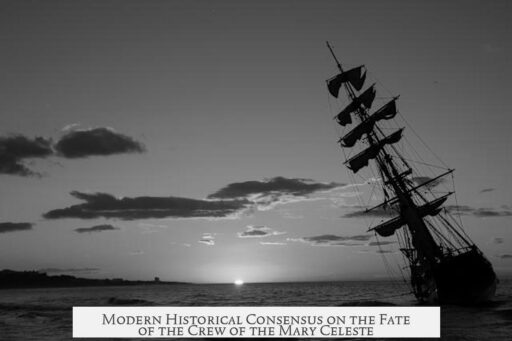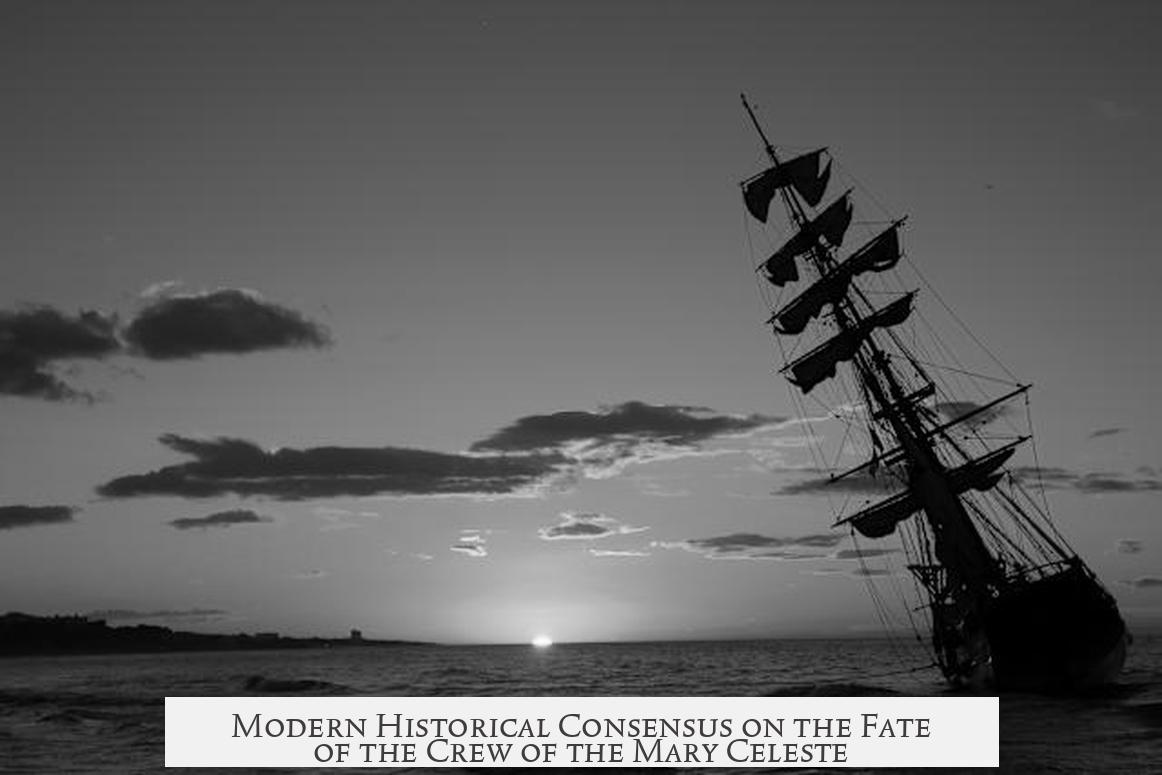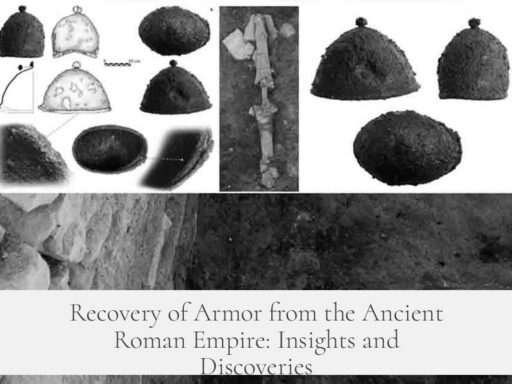The modern historical consensus on the fate of the crew of the Mary Celeste holds that the crew abandoned ship hastily due to a perceived, rather than actual, danger. Most researchers agree no evidence supports violent or supernatural events. Instead, the crew likely left fearing an explosion or flooding and perished at sea after their lifeboat was lost in rough conditions.
The Mary Celeste was an American brigantine found adrift and deserted in 1872 with all crew and passengers missing. Earlier sensational stories painted a mysterious disappearance, emphasizing that the vessel was seaworthy, sailing calmly under good conditions, and showed signs of normal life, such as a half-eaten meal and a ticking watch. These tales have since been corrected as inaccuracies and embellishments.
Research shows the brig was in damage after a heavy storm. Its sails were mostly furled, the rigging battered, and the decks soaked. Two hatches were off, the ship’s clock had stopped, and the last log entry was nine days before discovery. The ship’s papers, navigation tools, and lifeboat were missing. The crew left behind personal items like oilskins and maps, indicating an abrupt evacuation rather than a planned departure.
The cargo of nearly 1,700 barrels of raw alcohol is essential to understanding the cause. Some barrels leaked, and alcohol vapor could accumulate in the hold. One prevalent modern theory suggests the crew feared that these fumes might explode if a lantern or spark ignited them. Such fear could prompt abandoning the ship despite no fire or structural damage. The wooden brig carried a heavy insurance policy, but no credible evidence supports insurance fraud or conspiracy theories.
Supporting this, James H. Winchester, the shipowner, proposed that fumes escaping from leaking alcohol barrels triggered panic. Captain Benjamin Briggs, an experienced and careful seaman, might have opened the hold hatches to ventilate vapors, then took to a lifeboat tethered alongside. A sudden storm possibly separated the boat from the Mary Celeste, leading to the crew’s loss at sea. This aligns with the missing lifeboat and the wet condition of cabins and decks.
Other explanations include mistaken sounding of the water in the hold, leading to thoughts that the ship was foundering. Historical evidence shows the cargo hold had about 3.5 feet of water, a manageable amount with functioning hand pumps. No signs of violence or struggle appeared. An empty or partially empty barrel count suggests water leakage but no catastrophic hull breach. The crew’s personal belongings and daily items left behind argue against mutiny, piracy, or storm casualties onboard.
Numerous speculative and sensational theories have persisted over time. These include mutiny and murder, sea monster attacks, violent storms causing the crew to evacuate, paranormal influences, or Bermuda Triangle involvement. These theories lack primary evidence and are dismissed by historians. Arthur Conan Doyle’s famous short story introduced fictional elements like racial paranoia and survivors, which misled public perception but are purely imaginative.
The best detailed examination is Charles Edey Fay’s 1940s study, The Story of the Mary Celeste, which compiles extensive primary sources and carefully weighs the evidence without mythologizing. His work underpins modern understanding that the crew likely perished due to natural causes following a panicked abandonment.
- The Mary Celeste was found deserted in good condition after a storm.
- The crew abandoned ship fearing explosion or flooding, not fire or violence.
- The lifeboat was lost in rough seas; the crew probably drowned.
- Popular mystery details are inaccurate or fictionalized.
- Most credible modern theory involves alcohol vapor leaks causing panic.
- No evidence supports mutiny, piracy, or supernatural explanations.
- Primary sources analyzed by historians provide a factual narrative.
The Modern Historical Consensus on the Fate of the Crew of the Mary Celeste
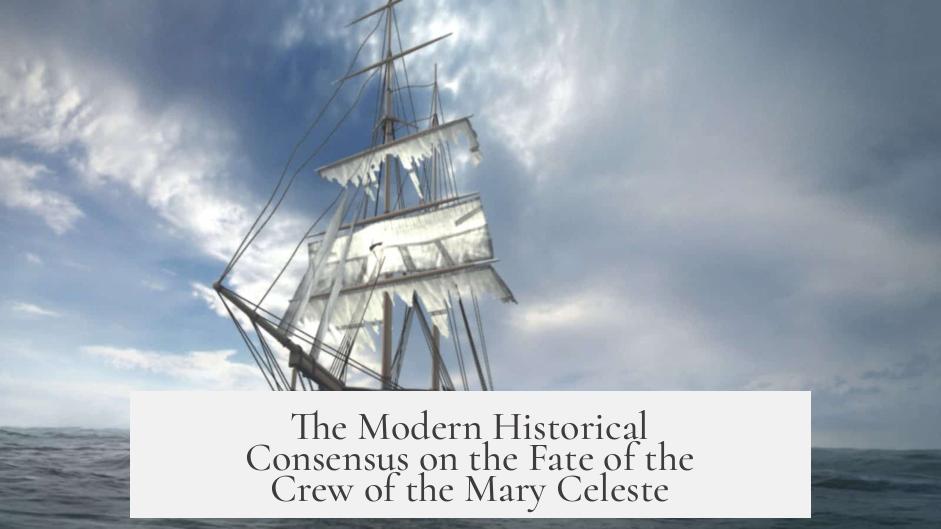
Is there a modern historical consensus on what happened to the crew of the Mary Celeste? Absolutely. Contrary to sensational tales and ghostly yarns, historians today mostly agree the crew abandoned ship due to a genuine fear—not fantasy—and likely perished at sea when their lifeboat capsized.
Let’s unpack this maritime mystery with a fresh, fact-rich perspective that tramples through myths and gets to the heart of the matter.
Setting the Scene: What Made the Mary Celeste Mystery Special?
In 1872, the American brig Mary Celeste left New York with eight crew members and two passengers aboard. Captain Benjamin Briggs helmed the voyage. Briggs was no reckless rookie. He was experienced, sober, respectable, and known for his reliable, religious character. The ship was sturdy and well-maintained, known for her seaworthiness — hardly the profile of a doomed vessel.
Months later, the Mary Celeste was found adrift in calm seas by the crew of the Dei Gratia. Here’s where the mystery blooms: the Mary Celeste was seaworthy, sails properly set, and carried a half-eaten meal and a still-ticking watch. No sign of desperation or violence. Every clue suggested the crew vanished without a trace.
Sorting Fact from Fiction: The Truth About the Mary Celeste’s Condition When Found
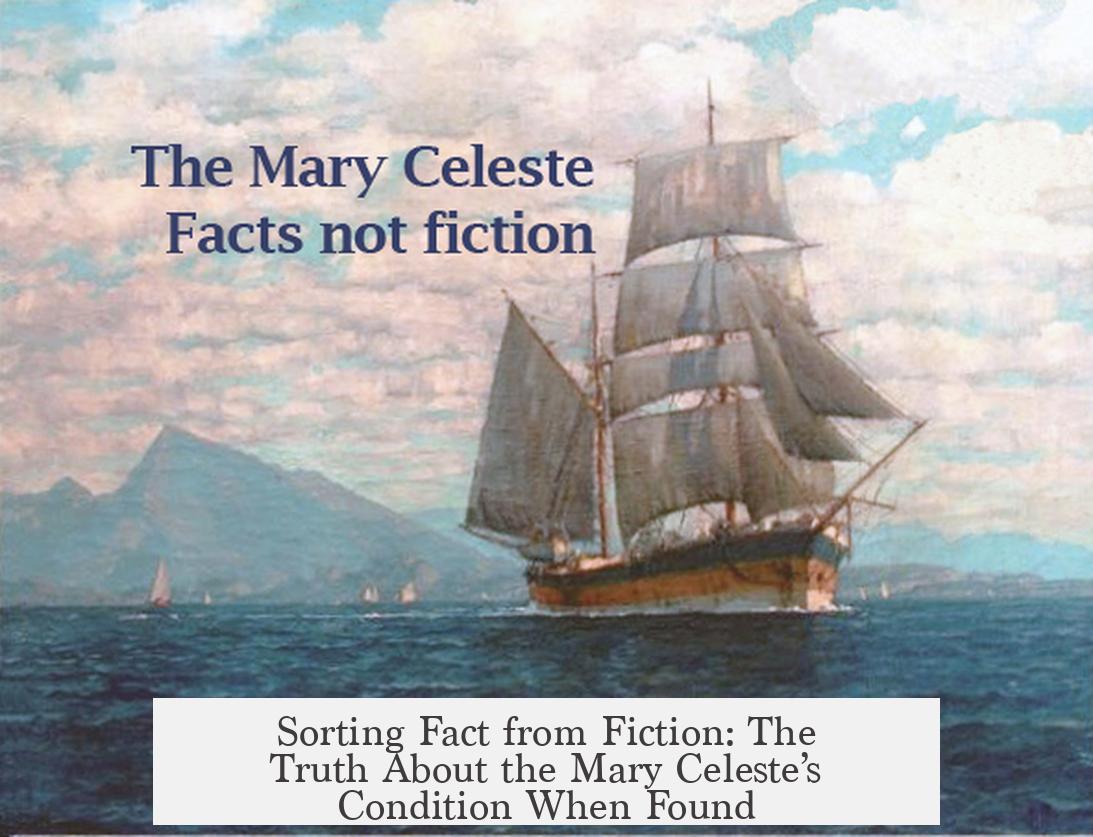
Popular stories often get things wrong. For example, many call it “Marie Celeste,” and claim the date of the voyage was 1873—not true. These errors mostly trace back to early reports and a splashy Arthur Conan Doyle story that romanticized the event.
Real evidence tells a more nuanced story:
When found, the Mary Celeste was running under only a jib and foresail—barely any canvas. The rigging was battered. Barrels of water had shifted on deck. The cabin interiors were soaked, signaling a heavy storm had passed. Hatches were off, the clock had stopped, and the last log entry was nine days prior.
Moreover, key items were missing: ship’s papers, navigation instruments, and the lifeboat. Food was secured for rough seas, signifying a sudden evacuation. The crew left oilskins and personal effects behind—no signs of violence or emergency gear grabbed for a frantic escape.
Why Did the Crew Abandon a Seaworthy Ship?
This question is the heart of the Mary Celeste mystery. Historians today suggest the crew panicked based on a real but misunderstood threat.
Several plausible theories stand out:
- Alcohol vapor leaks: The ship’s cargo consisted of 1,700 barrels of raw alcohol. It’s likely some barrels leaked, creating explosive vapors. When the crew lit a lantern, they may have feared an imminent explosion.
- Mistaken flooding fears: Water in the hold measured about 3.5 feet. The crew may have mistakenly thought the ship was sinking. Importantly, pumps were functional—but panic can cloud judgment.
- Storm aftermath: Signs of recent rough weather suggest the crew may have launched the lifeboat as a precaution, only for it to be lost in rough seas.
Could the captain have tethered the lifeboat to the ship, and a squall separated them? Or did a freak wave swamp the boat? Historians lean toward such plausible but tragic scenarios rather than violent mutiny or supernatural forces.
What About the Wild Theories?

Over the decades, wildly imaginative tales sprouted:
- Sea monsters abducting the crew.
- Gas clouds driving sailors insane.
- Religious cult madness and murder-suicide.
- Bermuda Triangle conspiracies.
- Mutiny backed by shaky ‘evidence’ from salvage lawyers.
- Even Arthur Conan Doyle’s fictional murder mystery involving non-existent survivors.
Modern historians dismiss these stories as colorful distractions. No physical or documented evidence supports them. They serve as entertaining fiction but not serious explanation.
Reliable Voices: What Experts Say
James H. Winchester—the Mary Celeste’s owner—suggested that alcohol vapors alarmed the crew and led to their frantic evacuation. Their lifeboat likely got lost in a sudden storm, doom quietly claiming them.
Another solid theory is a misjudged sounding of the hold—a simple mistake leading to a mistaken belief that the ship was foundering.
Both theories align with tangible facts, good seamanship knowledge, and situational evidence.
The Definitive Account
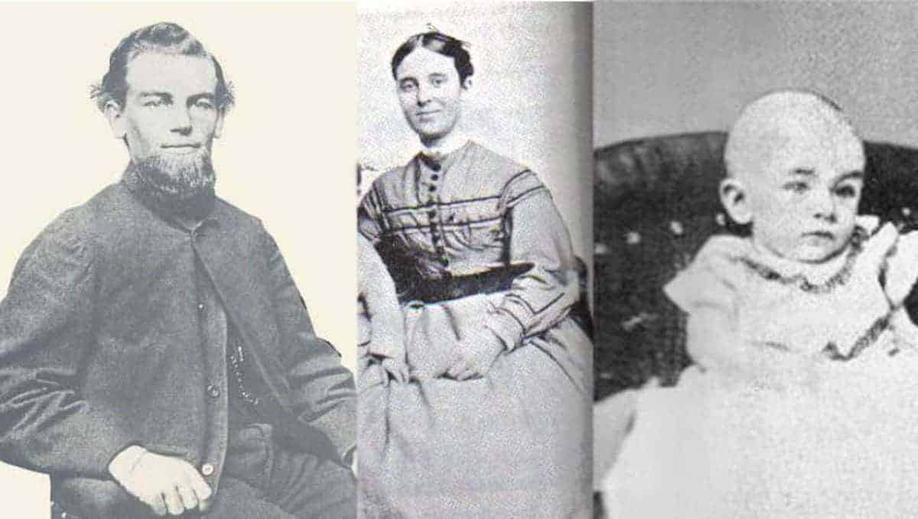
If you want a deep dive into the surviving documents, the best resource remains Charles Edey Fay’s The Story of the Mary Celeste (1940s). Fay doesn’t indulge in sensationalism but meticulously prints primary sources and analyzes them with care.
Contextualizing Mary Celeste
This mystery isn’t unique in maritime history. Other ships, like the Carroll A. Deering (1921) and the Joyita (1955), also saw crews vanish under enigmatic circumstances. These cases hint that peril at sea combined with human missteps often result in vanishings without dramatic violence or fantastical causes.
Wrapping It Up: What’s the Modern Historical Consensus?
Modern consensus keeps it simple and sober:
- The crew abandoned ship in a genuine panic. The Mary Celeste did not show signs of fire, violent struggle, or fatal leaks. Water in the hold was manageable.
- The likely cause was fear of an alcohol vapor explosion or mistaken belief the ship was sinking.
- The crew’s lifeboat was probably lost at sea during rough conditions, leading to the crew’s tragic, quiet disappearance.
- Many popular mystery details are simply errors or sensational embellishments, not evidence.
So, the famous Mary Celeste mystery? It’s less a ghost story and more a tale of human fear, the dangers of sea travel, and misunderstood peril. Next time you hear the story, imagine a resolute captain, a steady crew, and how a sudden storm and a whiff of alcohol fumes might have seeded a fatal misjudgment.
Ever wondered how fear can make sailors abandon a perfectly good ship? The Mary Celeste quietly teaches that not all mysteries need monsters or mutiny—sometimes, the sea’s unpredictability and human instinct provide all the drama needed.
What is the modern historical consensus about why the Mary Celeste’s crew abandoned the ship?
Historians believe the crew left due to fear of imminent danger, likely caused by alcohol vapors leaking and raising fears of an explosion. They abandoned ship hastily, although the vessel itself was still seaworthy.
Is there any credible evidence supporting mutiny or foul play aboard the Mary Celeste?
No solid evidence exists for mutiny or violence. Earlier claims of blood stains and axe marks are now dismissed. Modern research finds no signs of struggle or crime on board.
What most likely happened to the crew after they abandoned the Mary Celeste?
The crew probably took to a lifeboat, which was lost in heavy seas or a storm. It is assumed they perished at sea since the lifeboat never resurfaced or was found.
How do modern historians view fictional accounts like Arthur Conan Doyle’s story about the Mary Celeste?
Such stories are recognized as fiction with no basis in fact. They popularized myths and errors that misrepresent the actual events and conditions of the ship’s abandonment.
What key facts correct the popular myths about the Mary Celeste?
- The ship was found under short sail, not fully rigged.
- The last log entry was several days before discovery.
- No food was left on the table; plates were secured.
- Navigation tools and the boat were missing, indicating hasty departure.
Which sources provide the most reliable detailed study of the Mary Celeste mystery?
Charles Edey Fay’s 1940s book, The Story of the Mary Celeste, offers comprehensive analysis and primary documents, making it the definitive source for understanding the incident.
